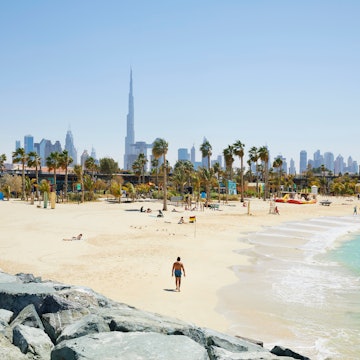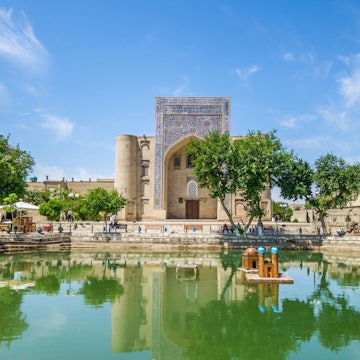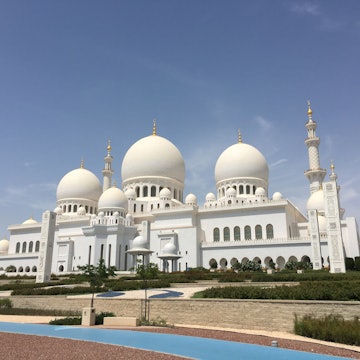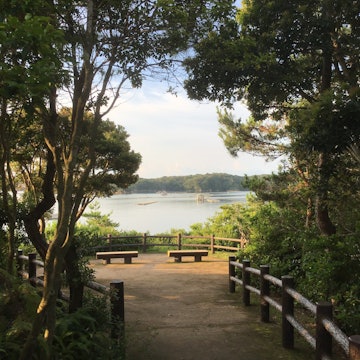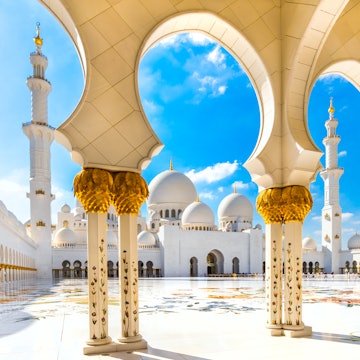
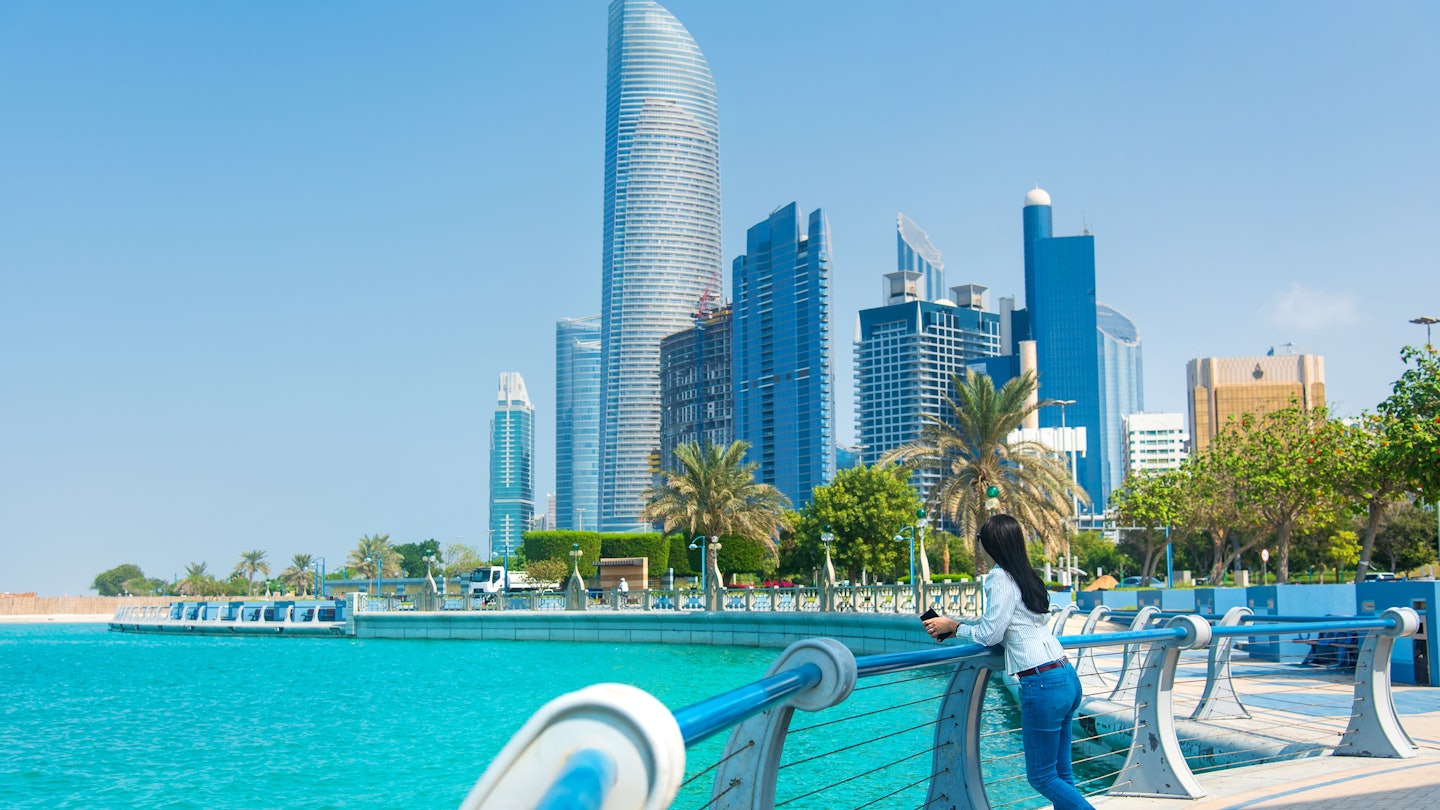
Abu Dhabi's weather patterns can have a big impact on your travels – here are the best times to go © Stefan Tomic / Getty Images
The vast desert landscapes, quiet beaches, verdant oases, heritage sites, interesting museums and thrilling theme parks of Abu Dhabi appeal to travelers who are after a deeper cultural experience in the UAE.
In summer, the emirate, like the rest of the UAE, experiences a blistering heat that makes visitors swap outdoor activities for shopping in air-conditioned malls, visiting museums, galleries and indoor theme parks, and eating their way around the city’s exciting food scene. Winter brings the best weather and understandably, the most tourists, driving up hotel prices. The spring and autumn months are ideal for budget travelers who don’t mind some warm days if it means fewer crowds at popular attractions and reasonable accommodation rates.
While Abu Dhabi is a year-round destination thanks to its diverse experiences, here’s a guide to the best times to visit Abu Dhabi and practical tips to plan your itinerary.

November to March is the best time for perfect weather and outdoor excursions
With comfortable daytime temperatures, beautiful blue skies and breezy evenings, winter in Abu Dhabi makes the warm and humid days of summer feel like a distant memory. The months from November to February are the best time to visit Abu Dhabi, especially if you want to spend time outdoors riding bikes along the Corniche, dining al fresco at beachfront cafes and kayaking in the Eastern Mangrove National Park. In November, expect temperatures between the mid-20°Cs and low 30°Cs (mid-70°Fs to low 80°Fs), with lows falling to the 16°C to 20°C (60 to 68°F) range over the next few months.
During this time, the opportunities are ripe to head to Abu Dhabi’s idyllic desert, whether to stay overnight for activities like stargazing and sandboarding or to simply watch the sunset over the dunes of Rub’ Al Khali (the Empty Quarter). Winter is the perfect time of year to visit Al Ain Oasis and nearby fortresses or enjoy a picnic at Jebel Hafit.
This being the high season, it is also when you’ll find the most crowds and the highest hotel prices. Expect hordes of tourists and tour buses at popular attractions such as Qasr Al Watan and Sheikh Zayed Grand Mosque. Book hotels at least a month or two in advance, buy skip-the-line tickets where possible and make reservations at popular restaurants.
March to May and mid-October to December are the best times for bright and beautiful beach days
The months from March to May, before the onset of brutally hot summer days, and from mid-October to December, before the ocean turns cold, are perfect if your idea of an Abu Dhabi vacation involves spending hours lounging by a hotel pool or swimming in the clear waters of Abu Dhabi’s beaches, like those on Saadiyat Island.
During these months, the days are bright and sunny minus the oppressive humidity of summer. With temperatures in the mid-20°Cs and low 30°Cs (mid-70°Fs to low 80°Fs) range, it’s warm enough to park yourself in a sun lounger under a parasol, and cool off with dips in the pool at a glamorous beach club or in the ocean.

March to May and September to October are the best times for budget travelers
For travelers visiting Abu Dhabi on a budget, the months from March to May and September to October offer the combination of decent weather (that allows for outdoor exploration) and relatively fewer crowds compared to the high season from November to February.
While this is not the time for the cheapest hotel rates (that’s something you’ll find in peak summer), prices fall to a comfortable mid-range and are significantly lower than those from November to February. The mild weather in March, April and October means it’s a good time to visit Abu Dhabi on an itinerary that includes experiences such as going on a desert safari, cycling around the Al Ain Oasis or strolling along the Corniche.
May and September are hot and humid, but it’s manageable (depending on who you ask), and the low hotel rates might make this time more suitable for budget travelers. Just remember to stay hydrated during outdoor activities.
November to March is the best time for festivals and events
As the days get cooler in November, Abu Dhabi comes alive with a calendar full of live events, open-air concerts, stand-up comedy shows, musical performances and cultural festivals in Abu Dhabi, Al Ain and elsewhere.
In November, over a hundred thousand Formula 1 fans from around the world gather on Yas Island’s Yas Marina Circuit for the Formula 1 Etihad Airways Abu Dhabi Grand Prix.
An annual event held in January, Al Dhafra Festival showcases the heritage of the UAE through camel beauty contests, falconry, Arabian horse racing, traditional markets and desert camps. Al Hosn Festival, held over 10 days in the historic Qasr Al Hosn, introduces visitors to Emirati traditions, food and handicrafts.
Winter sees Abu Dhabi host international talents in concerts held at the Etihad Arena and events like Saadiyat Nights see artists like John Legend, Tom Jones and Sting perform in open-air venues.
In February, pop-culture enthusiasts look forward to the Middle East Film and Comic Con. This weekend-long celebration of all things film, TV, sci-fi, anime, manga, gaming, comics and collectibles involves gaming tournaments, movie screenings and cosplay competitions.
Hotel rates can be slightly higher around the venues for major events, with high occupancy rates expected. So if you plan on attending a festival or event, book your accommodation well in advance.

June to August is the best time to avoid crowds
In the peak summer months from June to August, expect daytime lows of 31–35°C (87–95°F) and highs in the mid-40°Cs (around 105°F), with temperatures in August, the hottest month, reaching up to 47°C (116°F). Due to Abu Dhabi’s coastal location, relative humidity on some days can be over 60%, and occasionally, even higher.
At this time, the hazy views of the city’s skyline and milky skies aren’t particularly beautiful. The harsh heat means it’s not a good time to plan excursions to the desert, and even a short afternoon stroll around the markets of Al Mina or Umm Al Emarat Park will have you frequently reaching for a spot of shade and your bottle of water.
You’ll see few other tourists around and barely any outside of famous sights such as Sheikh Zayed Grand Mosque and Qasr Al Watan. Don’t be surprised to find that you’re the only one wandering under the arched walkways of the Qasr Al Hosn or around the art exhibitions of the Cultural Foundation.
While not many international tourists visit in summer, for residents, life goes on as usual, albeit indoors. Hotel rates are the lowest in June, July and August. If you’re visiting in the summer, plan to spend significant time exploring Abu Dhabi’s indoor attractions. Visit the Louvre Abu Dhabi, Manarat Al Saadiyat, Abrahamic Family House and Ferrari World Abu Dhabi, go shopping at The Galleria Al Maryah Island and enjoy city views over afternoon tea in the posh, air-conditioned Observation Deck at 300.







